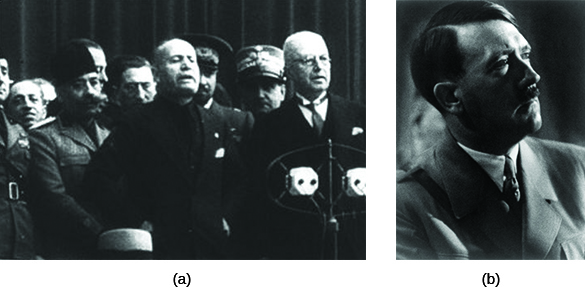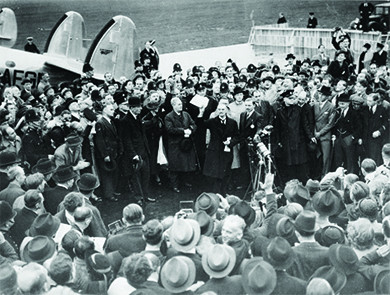| << Chapter < Page | Chapter >> Page > |

Once in power, Hitler began to rebuild German military might. He commenced his program by withdrawing Germany from the League of Nations in October 1933. In 1936, in accordance with his promise to restore German greatness, Hitler dispatched military units into the Rhineland, on the border with France, which was an act contrary to the provisions of the Versailles Treaty. In March 1938, claiming that he sought only to reunite ethnic Germans within the borders of one country, Hitler invaded Austria. At a conference in Munich later that year, Great Britain’s prime minister, Neville Chamberlain, and France’s prime minister, Édouard Daladier, agreed to the partial dismemberment of Czechoslovakia and the occupation of the Sudetenland (a region with a sizable German population) by German troops ( [link] ). This Munich Pact offered a policy of appeasement , in the hope that German expansionist appetites could be satisfied without war. But not long after the agreement, Germany occupied the rest of Czechoslovakia as well.

In the Soviet Union, Premier Joseph Stalin, observing Hitler’s actions and listening to his public pronouncements, realized that Poland, part of which had once belonged to Germany and was home to people of German ancestry, was most likely next. Although fiercely opposed to Hitler, Stalin, sobered by the French and British betrayal of Czechoslovakia and unprepared for a major war, decided the best way to protect the Soviet Union, and gain additional territory, was to come to some accommodation with the German dictator. In August 1939, Germany and the Soviet Union essentially agreed to divide Poland between them and not make war upon one another.
Militaristic politicians also took control of Japan in the 1930s. The Japanese had worked assiduously for decades to modernize, build their strength, and become a prosperous, respected nation. The sentiment in Japan was decidedly pro-capitalist, and the Japanese militarists were fiercely supportive of a capitalist economy. They viewed with great concern the rise of Communism in the Soviet Union and in particular China, where the issue was fueling a civil war, and feared that the Soviet Union would make inroads in Asia by assisting China’s Communists. The Japanese militarists thus found a common ideological enemy with Fascism and National Socialism, which had based their rise to power on anti-Communist sentiments. In 1936, Japan and Germany signed the Anti-Comintern Pact, pledging mutual assistance in defending themselves against the Comintern, the international agency created by the Soviet Union to promote worldwide Communist revolution. In 1937, Italy joined the pact, essentially creating the foundation of what became the military alliance of the Axis powers.

Notification Switch
Would you like to follow the 'U.s. history' conversation and receive update notifications?